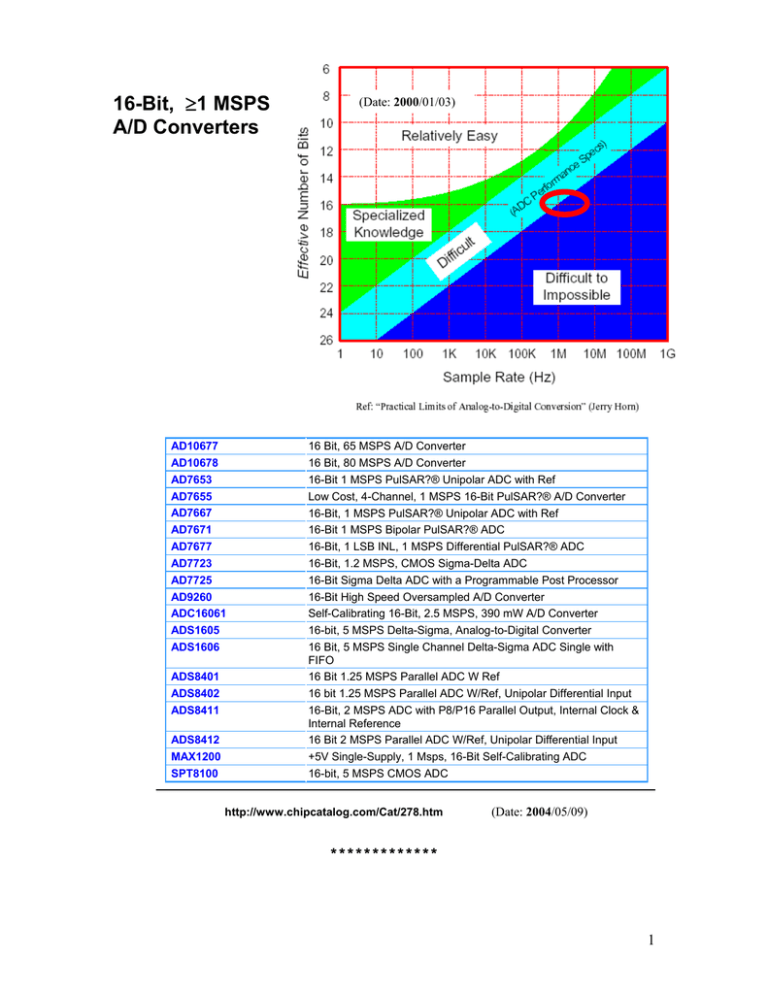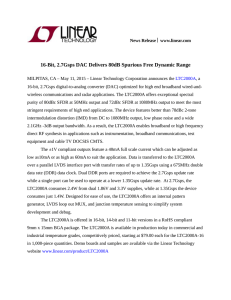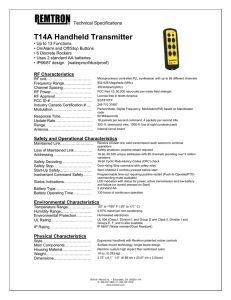
16-Bit, ≥1 MSPS
A/D Converters
AD10677
AD10678
AD7653
AD7655
AD7667
AD7671
AD7677
AD7723
AD7725
AD9260
ADC16061
ADS1605
ADS1606
ADS8401
ADS8402
ADS8411
ADS8412
MAX1200
SPT8100
(Date: 2000/01/03)
16 Bit, 65 MSPS A/D Converter
16 Bit, 80 MSPS A/D Converter
16-Bit 1 MSPS PulSAR?® Unipolar ADC with Ref
Low Cost, 4-Channel, 1 MSPS 16-Bit PulSAR?® A/D Converter
16-Bit, 1 MSPS PulSAR?® Unipolar ADC with Ref
16-Bit 1 MSPS Bipolar PulSAR?® ADC
16-Bit, 1 LSB INL, 1 MSPS Differential PulSAR?® ADC
16-Bit, 1.2 MSPS, CMOS Sigma-Delta ADC
16-Bit Sigma Delta ADC with a Programmable Post Processor
16-Bit High Speed Oversampled A/D Converter
Self-Calibrating 16-Bit, 2.5 MSPS, 390 mW A/D Converter
16-bit, 5 MSPS Delta-Sigma, Analog-to-Digital Converter
16 Bit, 5 MSPS Single Channel Delta-Sigma ADC Single with
FIFO
16 Bit 1.25 MSPS Parallel ADC W Ref
16 bit 1.25 MSPS Parallel ADC W/Ref, Unipolar Differential Input
16-Bit, 2 MSPS ADC with P8/P16 Parallel Output, Internal Clock &
Internal Reference
16 Bit 2 MSPS Parallel ADC W/Ref, Unipolar Differential Input
+5V Single-Supply, 1 Msps, 16-Bit Self-Calibrating ADC
16-bit, 5 MSPS CMOS ADC
http://www.chipcatalog.com/Cat/278.htm
(Date: 2004/05/09)
*************
1
acquisitionZONE Product Review: Texas Instruments ADS1610 16-Bit, 10-Msample/s Delta-Sigma ADC
acquisitionZONE Products for the week of August 29, 2005
Texas Instruments Says . . .
ADS1610: 16-Bit, 10-Msample/s Delta-Sigma ADC for Precision Measurements
Offers 86-dB SNR and 95-dB SFDR at 4x the Speed of Nearest Competition
Providing an unmatched combination of speed and precision, Texas Instruments Incorporated (TI)
announced a 16-bit, 10MSPS delta-sigma analog-to-digital converter (ADC). Featuring 86dB signal-tonoise ratio (SNR) and 95dB spurious-free dynamic range (SFDR) over a 5MHz bandwidth, the
ADS1610 provides state-of-the-art performance at 4x the speed of the nearest delta-sigma competition
and 2x the speed of TI's previous delta-sigma solutions. The ADS1610 is ideal for demanding
measurements in communications, scientific instrumentation and test and measurement applications.
"Texas Instruments has leveraged its expertise in high-performance data conversion to once again push
the boundaries in speed and precision," said Gregg Lowe, senior vice president of TI's high-performance
analog business. "This breakthrough data converter extends our industry-leading portfolio of delta-sigma
ADCs and provides our customers with outstanding high-speed performance for their most demanding
measurement applications."
The high-speed operation (10MSPS) is ideal for high-accuracy applications requiring higher sampling
speeds. The 16-bit resolution with 86dB SNR, 95dB SFDR and -94dB total harmonic distortion (THD)
is ideal for high-speed applications requiring higher accuracy signal measurement.
analogZONE Says . . .
I continue to be extremely impressed with this family of parts. It is tempting to say just read our
previous review of the ADS1605 and double the clocking rate, or look at the 18-bit 1.25 Msample/s
cousin in the form of the ADS1625, but that would not be doing this part enough justice, or courtesy.
Apart from the clock speed other things have changed. Power consumption has not doubled with speed
although it has increased from 110 mA to 150 mA on the 5-V analog supply and from 49 mA to 70 mA
on the 3-V digital/IO rail. And with a change in the oversampling ratio from 8x to 6x there are minor
changes in the dynamic numbers that are difficult to corelate between the parts. The signal bandwidth
has increased to 4.9 MHz (from 2.45 MHz) wth the 0.1 dB bandwidth now at 4.6 MHz; but the most
astonishing change is in the filter ripple characteristic with the passband at 4.4 MHz and a ripple of
±0.0002 dB. That's right, three zeroes after the decimal point!
Little else needs to be said. TI is introducing the ADS1610 at a lower price than the ADS1605
http://www.analogzone.com/acqp0829.htm (1 of 2)10/4/2005 2:46:30 PM
acquisitionZONE Product Review: Texas Instruments ADS1610 16-Bit, 10-Msample/s Delta-Sigma ADC
introduction (and it is still priced at $32.05 on TI's web site, though not for long one suspects) and is a
pin compatible upgrade to the earlier part. It will do extremely well.
The ADS1610 is sampling in TQFP-64 and will be priced at $29.95 in 1000-piece lots when production
starts in Q3 2005. Although the news release does not say it, the part will also be available in QFN-64.
Evaluation modules are available.
Data Sheet
●
●
Product Archives
Return to the acquisitionZONE
acquisitionZONE - audio/videoZONE - connectivityZONE - greenZONE - networkZONE - powerZONE technoteZONE - T&MZONE - wirelessZONE - endZONE - productARCHIVE
home
analogZONE
(c) 2005. All rights reserved.
http://www.analogzone.com/acqp0829.htm (2 of 2)10/4/2005 2:46:30 PM
Norwood, MA ( 5/9/2005 ) - Analog Devices, Inc. (NYSE:ADI) the world leader in data
converter technology, today introduced the industry’s first 16-bit analog-to-digital converter
(ADC) to deliver 100-MSPS (mega-samples-per-second) data rates while offering both best-inclass signal-to-noise ratio (SNR) and spurious-free dynamic range (SFDR).
AD9446 - 16-Bit, 80 MSPS / 100 MSPS A/D Converter
Features
100 MSPS guaranteed sampling
2.3 W power dissipation
rate
3.3 V and 5 V supply operation
100 dB two-tone SFDR with 30
2.0 V p-p to 3.2 V p-p differential
MHz and 31 MHz
full-scale input
81.6 dB SNR with 30 MHz input
LVDS outputs (ANSI-644
(3.2 Vp-p input, 80 MSPS)
compatible) or CMOS outputs
90 dBc SFDR with 30 MHz input
Data format select (Offset Binary or
(3.2 Vp-p input, 80 MSPS)
2’s compliment)
Excellent linearity DNL = ±0.5 LSB
Output clock available
typical INL = ±3.0 LSB typical
http://www.analog.com/en/prod/0%2C2877%2CAD9446%2C00.htmlT
2
LTC News for Immediate Release
For more information, tel. 408-432-1900
John Hamburger, Dir., Mkting Communications, ext. 2419
Doug Dickinson, Media Relations Mgr., ext. 2233
www.linear.com
16-bit, 130Msps ADC Delivers 100dBc SFDR for High Performance
Receivers & Instrumentation
Fastest 16-Bit ADC Enables Leading Edge Development for Applications Demanding the
Highest Dynamic Range Specifications
MILPITAS, CA – September 6, 2005 – A new 16-bit, 130Msps ADC (Analog-to-Digital
Converter) by Linear Technology Corporation extends the company’s leadership in high speed
(ADCs) for the most demanding wideband, low noise, signal acquisition applications. The
LTC2208 ADC addresses the key requirements for maximizing performance of high sensitivity
receivers and data acquisition systems. The device’s exceptional spurious free dynamic range
(SFDR) performance of 100dBc, combined with 78dB signal to noise ratio (SNR), enable it to
resolve low level signals in the presence of large interferers and blockers. The LTC2208 is the
fastest 16-bit, high performance ADC on the market today.
The LTC2208 family innovates ADC technology for digital receivers by incorporating
two unique features that simplify receiver design and improve system performance. The first is
an internal transparent dither circuit that improves the ADC’s spurious free dynamic range
(SFDR) response well beyond 100dBc for low level input signals. The second feature is a digital
output randomizer that dramatically reduces unwanted tones caused by digital feedback. The
flexible digital outputs can be run as CMOS or LVDS.
The LT2208 also features a programmable gain amplifier (PGA) front end that eases the
ADC driver output power requirements when driving the lower input range of 1.5 Vp-p. This
improves the distortion performance and power consumption of the driver with minimal impact
on ADC noise performance.
(more...)
16-bit, 130Msps ADC Delivers 100dBc SFDR for
High Performance Receivers & Instrumentation
Page 2
The LTC2208 packages an extensive feature set in a 9mm x 9mm QFN package
delivering low power consumption at 1250mW without the need for heat sinking. Most
importantly, both the power consumption and total solution size with integrated bypass
capacitance are less than half that of the nearest competitor. Designed for ease of use, it requires
only a single 3.3V supply for operation and comes with a clock duty cycle stabilizer for
maintaining the ADC performance over varying duty cycles. The LTC2208 can accept high
frequency, wide dynamic range signals, offering a wide analog input bandwidth of 700MHz.
The LTC2208 family includes speed grades of 130Msps, 105Msps, 80Msps, 65Msps,
40Msps, 25Msps and 10Msps all with superior SFDR and SNR performance. In addition to the
16-bit parts, 14-bit versions of this family will also be available. All devices are supported with
demo boards for quick device evaluation. Samples and demo boards for the LTC2208 are
available today, and production quantities in October for both commercial and industrial
temperature grades and are competitively priced at $65 each in 1,000-piece quantities.
The following table provides the entire LTC2208 product family. All parts can be
ordered in optional lead free packages for RoHS compliance.
Part Number
Resolution
Speed
Power
Availability
Price (1k)
LTC2208
16-bit
130Msps
1250mW
Now
$65.00
LTC2207
16-bit
105Msps
850mW
Oct
$56.67
LTC2206
16-bit
80Msps
640mW
Oct
$48.33
LTC2205
16-bit
65Msps
450mW
Oct
$43.33
LTC2204
16-bit
40Msps
350mW
Oct
$35.00
LTC2203
16-bit
25Msps
220mW
Oct
$30.00
LTC2202
16-bit
10Msps
150mW
Oct
$25.00
LTC2208-14
14-bit
130Msps
1250mW
Nov
$55.00
LTC2207-14
14-bit
105Msps
850mW
Nov
$45.00
LTC2206-14
14-bit
80Msps
640mW
Nov
$33.00
LTC2205-14
14-bit
65Msps
450mW
Nov
$28.00
Fast 16-bit A/D converter fits comm's bill
Fast 16-bit A/D converter fits comm's bill
By Bettyann Liotta, eeProductCenter
Sep 8 2005 (0:10 AM)
URL: http://www.eeproductcenter.com/showArticle.jhtml?articleID=170701333
Sunnyvale, Calif. — Maxim Integrated Products Inc. said it's setting a new industry
standard in dynamic performance with its fastest (80 Megasamples/second) 16-bit
analog-to-digital converter yet.
The MAX19586 offers superior dynamic performance including a noise floor of -82 dBfs,
80 dB SNR, and 96 dBc spurious-free dynamic range (SFDR) at an input frequency of 10
MHz (-2 dB input amplitude), said Ted Tewksbury, managing director of Maxim's highspeed signal processing business unit.
This performance is several dBs better than the competition in noise floor, SNR, and
SFDR, Tewksbury said. It can also sample input frequencies beyond 170 MHz.
"Maxim leveraged its leadership data-converter technology to produce a high-speed ADC
that advances the state of the art along both the dynamic performance and power axes,"
Tewksbury said. "This remarkable performance is achieved at half the power required by
http://www.eeproductcenter.com/printableArticle.jhtml?printable=true&articleID=170701333 (1 of 4)9/19/2005 11:38:32 AM
Fast 16-bit A/D converter fits comm's bill
the nearest competitor in a package that is one quarter the size."
The MAX19586 is a 3.3 V A/D converter with a fully differential wideband track-and-hold
(T/H) and a 16-bit converter core. Not only designed for excellent operation in the 2nd
Nyquist region, the MAX19586 is also optimized for use with high-IF input frequencies.
This makes the part suited for high-performance digital receivers. The part has a 1.8-V
digital supply voltage and a 2.56-V peak-to-peak full-scale input range.
"It is one thing to advance dynamic performance, but it is another thing to do that at
almost half the power," said Maher Matta, business manager for the company's highspeed converter products. At 1.1 W power dissipation, the MAX19586 uses 48 percent
less power than the nearest competitor. This part is also packaged in a space-saving 56pin QFN-EP, one fourth the size of that same competitor. This device is specified for the 40°C to +85°C industrial temperature range.
The performance of the MAX19586 is said to make it practical for high-performance
broadband applications. Applications include cellular base-station transceiver systems
(BTS), multicarrier and multistandard communication receivers, E911 location receivers,
antenna array processing, and high-end test and measurement instrumentation.
See related FFT chart
The MAX19586 provides the best combination of SNR and SFDR in the industry, according to Maxim.
This allows system engineers to design communication receivers with extra sensitivity and aids the
design of multicarrier receivers. The excellent 96 dBc SFDR performance eases filtering requirements,
and less expensive filters reduce system costs. The large dynamic range can also be utilized to simplify
system design by eliminating the need for variable gain attenuators (VGA) or automatic gain control
(AGC) blocks in the receiver. This is especially important in systems where the receiver is expected to
digitize both weak and strong signals. With over 80 dB of dynamic range, the system can capture both
signals without having to change gain ranges.
In subsampling applications, the MAX19586 offers superior performance at high IF (77.2 dB SNR at an
input frequency of 168 MHz), which allows system designers to eliminate RF down-conversion stages
without sacrificing overall system performance. In instrumentation applications, the superb noise floor
will quickly yield instruments with more measurement sensitivity than before.
See related SNR vs. Analog Input chart
The MAX19586 is available today. Pricing is $59.25 (1000-up, FOB USA). Click here for the MAX19586
data sheet.
Maxim, 1-800-998-8800, www.Maxim-ic.com.
http://www.eeproductcenter.com/printableArticle.jhtml?printable=true&articleID=170701333 (2 of 4)9/19/2005 11:38:32 AM
Fast 16-bit A/D converter fits comm's bill
The 16-bit monolithic high-speed converter market is heating up — In addition to Maxim's MAX19586
unveiling, there have been two other recent announcements from Analog Device Inc. (Norwood,
Mass.) and Linear Technology Corp. (Milpitas, Calif.)
See Maxim block diagram
While Linear Tech's LTC2208 clearly offers the highest sampling rate of the three devices at 130
Megasamples/second, Maxim's converter offers solid SNR and SFDR performance. Maxim's MAX19586
is the first device in a new family — higher-speed versions will soon follow, Maxim's Matta said.
All of these A/D converters are intended for use in demanding wideband communications applications,
especially basestation receivers, as well as instrumentation and some other high-end type applications.
Cellular basestations have evolved from supporting voice only to supporting data and video also,
which requires the receiver to have additional capacity. "The dB advantage we have will increase
receiver sensitivity and enable our product to support multicarrier receivers," Matta said.
Instrumentation applications also require strong dynamic performance to resolve small signals. "Our A/
D converter will result in instruments that have more sensitivity, which will enable them to measure
smaller signals," Matta said.
It's also important to note that Maxim's MAX19586 includes an integrated buffer on the front end —
which does effect power consumption (1.1 W). "Integrated buffers make it easier to drive the A/D
converter depending on input frequency and the topology of the input network — but it results in
additional power consumption," Matta said.
On the other hand, if buffers are needed and they aren't included, then you have to figure out a way
to drive the sampling converter yourself — with your own external buffer or transformer.
Most companies tend to offer either one version or the other — with or without buffers. However,
Maxim is now considering offering one product family in both versions to customers, Matta said.
Linear Technology's LTC2208 includes two unique features that are said to simplify receiver design
and boost system performance — an internal transparent dither circuit to improve the converter's
SFDR response beyond 100 dBc, and a digital output randomizer to reduce unwanted tones caused by
digital feedback.
LTC's A/D converter delivers 78 dB SNR and 100 dBc SFDR at 10 MHz.
Click here too see more details on LTC's LTC2208 at eeProductCenter.
ADI ranks second in terms of speed at 100 Msamples/s (AD9446) with SNR of 76 dB and SFDR of 90
http://www.eeproductcenter.com/printableArticle.jhtml?printable=true&articleID=170701333 (3 of 4)9/19/2005 11:38:32 AM
Fast 16-bit A/D converter fits comm's bill
dBc at 10 MHz. The company also has an 80 Msamples/s A/D converter that achieves 82 dBfs SNR and
85 dBc SFDR.
Click here too see more details on ADI's AD9446 at eeProductCenter.
Maxim's MAX19586 and Linear's LTC2208 are available in production quantities now. ADI is expected
to offer production quantities next month.
Linear's LTC2208 comes in a 9mm x 9mm QFN and consumes 1,250 mW of power, compared to ADI's
AD9446, which is packaged in a 16mm x 16mm TQFP and consumes 2,500 mW of power. Maxim's A/
D converter is housed in an 8mm x 8mm, 56-pin TQFN and uses 1.1 W of power.
Linear Tech's LTC2208 and ADI's AD9446 are available in both low-voltage differential signaling
(LVDS) and CMOS outputs. Maxim's MAX19586 offers CMOS outputs.
Linear also has a 16-bit, 105 Msamples/s (LTC2207) converter, with 78 dB SNR and 100 dBc SFDR at
10 MHz. It comes in a 7mm x 7mm QFN and consumes only 850 mW.
Pricing is $65.00 for LTC's 130 Msample/s device (LTC2208), $56.67 for its 105 Msamples/s version
(LTC2207), $79.70 for ADI's AD9446 and $59.25 for Maxim's MAX19586 device — all in 1,000-piece
quantities.
Analog Devices, 1-800-262-5643, www.analog.com.
Linear Technology, 1-800-454-6327, www.Linear.com.
Copyright 2005 © CMP Media LLC
http://www.eeproductcenter.com/printableArticle.jhtml?printable=true&articleID=170701333 (4 of 4)9/19/2005 11:38:32 AM
ANALOG DEVICES’ 16-BIT DATA CONVERTERS ACHIEVE BEST-IN-CLASS SIGNAL-TO-NOISE RATIO AND IF
SAMPLING PERFORMANCE
New AD9460 and AD9461 ADCs deliver true 16-bit resolution for instrumentation, radar, medical imaging, and communication
systems.
Norwood, MA(3/14/2006) - Analog Devices, Inc. (NYSE: ADI), the
world leader in data converter technology, is expanding its portfolio of
high-performance analog-to-digital converters (ADCs) with the
introduction of two devices targeted for high-end instrumentation,
medical and wireless communications applications that enable
designers to maintain low noise and high dynamic range, even at high
input frequencies. Designers of medical systems, such as magnetic
resonance imaging and patient monitoring receivers, which involve
complex, multi-channel designs will benefit from the new converters
which offer the highest signal to noise ratio (SNR) at 79dB, and deliver
16-bit precision at high IFs (intermediate frequency) and supporting
sampling rates up to 130 MSPS (mega samples per second). In
addition to an internal buffer that isolates and eases driving of the ADC
inputs, the new devices offer 15 percent lower jitter than existing
solutions — an important factor in maintaining low system noise floors.
The new converters – the AD9460 and AD9461 – provide 16-bit
performance up to 130 MSPS, enabling the high dynamic range
required for signal analysis, radar, magnetic resonance imaging (MRI),
and multi-carrier/multi-std wireless communications systems. In these
designs, higher ADC sampling rates allow engineers to capture and digitize wider signal bandwidths and to
handle higher Tesla magnetic fields for superior imaging in MRI. In addition, the AD9460 and AD9461 operate
with lower power to aide in multi-channel systems. The AD9460, offered at 80 MSPS and 105 MSPS sampling
rates, consumes 1.4 W and 1.6 W respectively. At its highest sampling rate of 130 MSPS, the AD9461 consumes
1.9 W.
“System designers are challenged with converter performance trade-offs in order to optimize their dynamic range, speed and
power. For devices requiring very high image quality, for example, the need for high sampling rates for faster data capture
while maintaining high accuracy and SNR can increase ADC power,” said Kevin Kattmann, product line director, high-speed
signal processing, Analog Devices. “Leveraging the superior performance of our AD9446, we are able to deliver these higher
sampling rate extensions to our 16-bit ADC family at significantly lower power dissipation. The AD9460 and AD9461 offer the
wide bandwidth, high speed, exceptional linearity and low noise our customers have come to expect from the AD9446 family.”
About the AD9460 and AD9461
The AD9460 and AD9461 ADCs feature an 80dBFS noise floor, SNR of 79db and true 16-bit linearity (DNL =
±0.5 LSB). SFDR is superior at 84dB with an input frequency range of 170MHz-250MHz. Both devices include an
integrated input buffer to isolate the ADC input, eliminating the need for external buffering that can consume up to
1 W of power, thereby easing the driving of the ADC, whether driven by transformers or amplifiers.
When input amplifiers are required for signal amplification or single-ended to differential conversion, the AD8138
and AD8139 are ideal for driving the AD9460 and AD9461 at baseband (<100MHz) input frequencies, and the
AD8352 serves as an excellent IF-Sampling (>100MHz) input amplifier. The flexible, 2-4Vpp input voltage range
of the AD9460 and AD9461 allow designers to optimize SNR and SFDR depending on their sampling rate and
input frequency.
The devices join a family of converters designed to deliver exceptional signal noise reduction, high resolution and
fast sampling rates. The first device in the family, the AD9446, was introduced last May and released last
October.
Pricing and Availability
The AD9460 and AD9461 ADCs are sampling now with production quantities available in March. Available in a Pb-free, 100-lead surface
mount plastic package (100-lead TQFP/EP), the AD9460 is priced at $48.33 (80 MSPS) and $56.67 (105 MSPS), and the AD9461 (130
MSPS) is priced at $65.00, each in 1,000-unit quantities.



